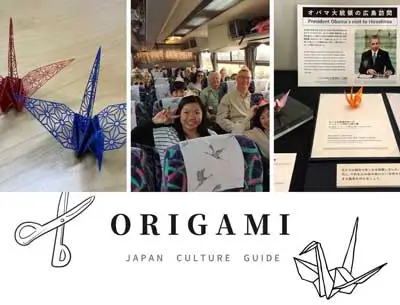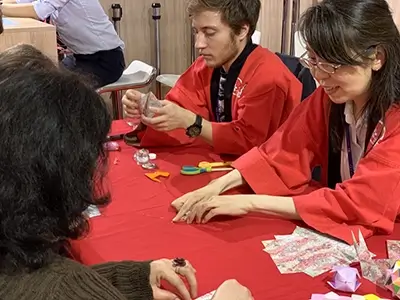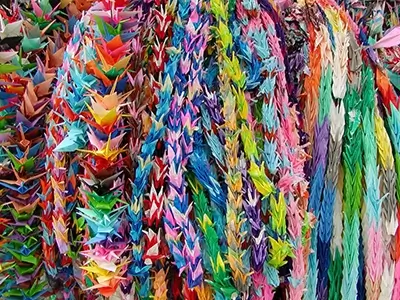Origami (折り紙, literally ‘fold paper’) is the Japanese art of folding paper without using scissors or glue. It’s a form of art in which shapes that look like paper sculptures are created. The origin of origami is linked to Zen culture, and the practice of origami can be considered a form of meditation in some cases. Today, origami skills are passed on from parents to children at home and also taught in kindergarten. So, most Japanese people know how to fold one thing in origami. What’s the history of origami? And do you still see it in Japan today? Read more in this Japan Culture Guide!


Ancient History
At the beginning of the 7th century, the method for papermaking was introduced to Japan from China. The Japanese succeeded in producing a thin and strong paper called washi (和紙, literally ‘Japanese paper’) Initially, these papers were used to record and copy sutras. Gradually the Japanese began to use them for Shinto rituals. For religious ceremonies, various things such as offerings to the gods were wrapped in washi paper. Eventually, folding the paper beautifully to wrap and decorate gifts and became a kind of ritual.
Between the 14th and 15th centuries, the Ogasawara and Ise families developed a variety of uses for paper. The labeling of wrapping paper (儀礼折り, girei-ori) also developed during this period. Eventually, the folding of the paper was no longer only about the result. More than that, it became a means of appreciating the folding itself. This was the time that folding paper started to be called ‘origami’. During the Edo period (1603-1868), paper production increased and origami became even more popular with the general public. In 1797, the world’s oldest book on origami, “Hifu Senbazuru Origata”, was published.
Origami in Modern History

During the Meiji Era (1868-1912), origami was introduced into kindergarten education and was also taught in elementary school. Origami then became increasingly popular in Japan. But it has evolved especially quickly since the late ’60s until today. According to some experts, we are in the most important moment in the history of origami. New design techniques have been discovered and popularized. These ideas have spread thanks to the Internet and origami associations around the world.
The incorporation of mathematics is a new topic, not considered in the past, that has gained strength in the last 30 years. Computing from the 1990s onwards has enabled optimization of the use of paper and new bases for complex figures such as insects. Paper transforms into shapes of different sizes starting from an initial square or rectangular base that can go from simple models to highly complex folds.
Origami models the environment that surrounds us and in which we live. Fauna and flora of all continents, urban life, tools of our daily life, mythological animals, and an endless number of other figures. Today, origami has spread all over the world and the art of origami is appreciated all over the world.
Origami in the Life of Japanese People
Origami is something indispensable in the life of Japanese people and especially the crane, Tsuru (鶴), is loved. Most Japanese know how to fold paper cranes. Japanese tradition says that if you can make 1000 cranes out of origami paper, your wish comes true. This ritual is often done for sick people. The family or/and friends of a sick person offer them a bouquet of 1000 origami paper cranes so that his illness can be cured as soon as possible.
We can see this Japanese custom in Hiroshima. In the Hiroshima Peace Park, around the memorial statue of Sadako, we can see the bunches of folded cranes offered by children. Sadako was a victim of the atomic bomb explosion in Hiroshima. She folded the 1000 cranes hoping to be cured of her illness (leukemia). In spite of the realization of 1000 cranes, her wish was not realized and she died at the age of 12.
After this tragic fact, her friends and many other Japanese decided to create a memorial in the Hiroshima Peace Park with the symbolic cranes. Since then, the crane has also become the symbol of Peace. In the Hiroshima Peace Museum, we can see the cranes made by Sadako.
If you are interested in (Japanese) paper and origami, there are various places of interest to visit in Japan such as Ozu Washi in Nihonbashi (Tokyo), the Tokyo Origami Museum in Kanda (Tokyo), and the Kyoto Handicraft Center.
Your Japan Tour
As seasoned Japan experts, we create perfect Japan package tours including destinations like Hiroshima. Check out our group tours and private tours, or contact us to start planning your unforgettable holiday to this fascinating country full of once-in-a-lifetime experiences, culture, history, nature, and delicious food!